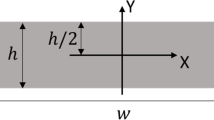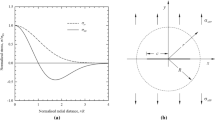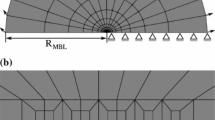Abstract
Large deformation finite element analysis has been carried out to investigate the stress-strain fields ahead of a growing crack for compact tension (a/W=0.5) and three-point bend (a/W=0.1 and 0.5) specimens under plane stress condition. The crack growth is controlled by the experimental J-integral resistance curves measured by Sun et al. The results indicate that the distributions of opening stress, equivalent stress and equivalent strain ahead of a growing crack are not sensitive to specimen geometry. For both stationary and growing cracks, similar distributions of opening stress and triaxiality can be found along the ligament. During stable crack growth, the crack- tip opening displacement (CTOD) resistance curve and the cohesive fracture energy in the fracture process zone are independent of specimen geometry and may be suitable criteria for characterizing stable crack growth in plane stress.
Similar content being viewed by others
References
ABAQUS User's manual, Version 5.4, (1996). Hibbitt, Karlsson and Sorensen, Inc., Providence, R.I.
Al–Ani, A.M. and Hancock, J.W. (1989). J–dominance of short cracks in tension and bending. Advances in Fracture Research (1CF7). (Edited by K. Salama, K. Ravi–Chandler, D.M.R. Taplin and P. Rama Rao), Pergamon Press, New York pp. 3817–3826.
ASTM, Standard (1987). Test Method for Determining J–RCurves (E1152–87), Annual Book of ASTM Standards, American Society for Testing and Materials, Philadelphia (1987) 03.01. pp. 853–863.
Barenblatt, G.I. (1962). The mathematical theory of equilibrium crack in brittle fracture. Advances in Applied Mechanics 7, 55–129.
Bloom, J.R., Lee, D.R. and Van Der Sluys, W.A. (1993). An investigation of size and constraint effects on ductile crack growth. Constraint Effect in Fracture, ASTM STP 1171. (Edited by E.M. Hackett, K.–H. Schwalbe and R.H. Dodds). American Society for Testing and Materials, Philadelphia pp. 383–417.
Brocks, W. and Schmitt, W. (1995). The second parameter in J–Rcurves: constraint or triaxiality? Constraint Effects in Fracture: Theory and Applications, ASTM STP 1244. (Edited by M. Kirk and A. Bakker), American Society for Testing and Materials, Philadelphia pp. 209–231.
Dean, R.H. (1983). Elastic–plastic steady crack growth in plane stress. Elastic–Plastic Fracture: Second Symposium, Volume I–Inelastic Crack Analysis, ASTM STP 803. (Edited by C.F. Shih and J.P. Gudas), American Society for Testing and Materials, Philadelphia, pp. 39–51.
Deng, H.T. and Wang, T.C. (1989). Plane stress elastic–plastic fracture criterion and stress strain field around crack tip. Advances in Fracture Research (ICF7). (Edited by K. Salama, K. Ravi–Chandler, D.M.R. Taplin and P. Rama Rao), Pergamon Press, New York, pp. 323–327.
Dugdale, D.S. (1960). Yielding of stress sheets containing slits. Journal of Mechanics and Physics of Solids 8, 100–108.
Hancock, J.W. (1983). Fundamentals of the phenomenological theory of nonlinear fracture mechanics. Journal of Applied Mechanics 50, 1042–1051.
Hutchinson, J.W. (1968). Singular behaviour at the end of a tensile crack in a hardening material. Journal of Mechanics and Physics of Solids 16, 13–31.
Joyce, J.A. and Link, R.E. (1995). Effects of constraint on upper shelf fracture toughness. Fracture Mechanics: 26th Volume, ASTMSTP 1256. (Edited by W.G. Reuter, J.H. Underwood and J.C. Newman), American Society for Testing and Materials, Philadelphia pp. 142–177.
Mai, Y.W. and Cotterell, B. (1995). Effect of specimen geometry on the essential work of plane stress ductile fracture. Engineering Fracture Mechanics 21, 123–128.
Narasimhan, R., Rosakis, A.J. and Hall, J.F. (1987). A finite element study of stable crack growth under plane stress conditions: Part I – elastic–perfectly plastic solids. Journal of Applied Mechanics 54, 838–853.
O'Dowd, N.P., Shih, C.F. and Dodds, Jr, R.H. (1994). The role of geometry and crack growth on constraint and implications for ductile/brittle fracture. Constraint Effect in Fracture: Theory and Application, ASTM STP 1244. (Edited by M. Kirk and A. Bakker), American Society for Testing and Materials, Philadelphia, pp. 134–159.
Rice, J.R. (1968). A path independent integral and the approximate analysis of strain concentration by notches and cracks. Journal of Applied Mechanics 35, 379–386.
Rice, J.R. (1982). Elastic–plastic crack growth. Mechanics of Solids. (Edited by H.G. Hopkin and M.J. Sewell), Pergamon Press, Oxford, pp. 539–562.
Rice, J.R. and Rosengren, G.F. (1968). Plane strain deformation near a crack tip in a power–law hardening material. Journal of Mechanics and Physics of Solids 16, 1–12.
Roelfstra, P.E. and Wittmann, F.H. (1986). Numerical method to link strain softening. Fracture Toughness and Fracture Energy of Concrete. (Edited by F.H. Wittmann), Elsevier Applied Science, London, pp. 163–175.
Roos, E., Eisele, U. and Silcher, H. (1993). Effect of stress state on the ductile fracture behaviour of large–scale specimens. Constraint Effect in Fracture, ASTM STP 1171. (Edited by E.M. Hackett, K.–H. Schwalbe and R.H. Dodds), American Society for Testing and Materials, Philadelphia, pp. 41–63.
Shih, C.F. and German, M.D. (1981). Requirement for a one parameter characterization of crack tip field by the HRR singularity. International Journal of Fracture 17, 27–43.
Sorem, W.A., Dodds, Jr, R.H. and Rolfe, S.T. (1991). Effects of crack depth on elastic–plastic fracture toughness. International Journal of Fracture 47, 105–126.
Sorensen, E.P. (1978). A finite element investigation of stable crack growth in anti–plane shear. International Journal of Fracture 14, 485–500.
Sun, J. (1989). Effect of triaxiality on ductile damage and elastic–plastic fracture. Ph.D. thesis, Xian Jiaotong University, Xian.
Sun, J., Deng, Z., Li, Z. and Tu, M. (1990). Plane stress elastic–plastic fracture criteria and constraint intensity in crack tip region. Engineering Fracture Mechanics 36, 321–326.
Sun, J., Deng, Z. and Tu, M. (1990). Plane stress elastic–plastic fracture criteria and constraint intensity in crack tip region. Engineering Fracture Mechanics 37, 675–680.
Swadener, J.G. and Liechti, K.M. (1998). Asymmetric shielding mechanisms in the mixed–mode fracture of glass/epoxy interface. Journal of Applied Mechanics 65, 25–29.
Tvergaard, V. and Hutchinson, J.W. (1992). The relation between crack growth resistance and fracture process parameters in elastic–plastic solids. Journal of Mechanics and Physics of Solids 40, 1377–1397.
Tvergaard, V. and Hutchinson, J.W. (1994). Toughness of an interface along a thin ductile layer joining elastic solids. Philosophical Magazine 70, 641–656.
Wittmann, F.H., Rokugo, K., Bruhwiler, E., Mihashi, H. and Simonin, P. (1988). Fracture energy and strain softening of concrete as determined by means of compact tension specimens. Materials and Structures 21, 21–32.
Wnuk, M.P. (1974). Quasi–static extension of a tensile crack contained in a viscoelastic–plastic solid. Journal of Applied Mechanics 41, 234–242.
Wu, S.X., Mai, Y.W., Cotterell, B. and Le, C.V. (1991). Ductile–brittle fracture transition due to increasing crack length in a medium carbon steel. Acta Metallurgica et Materialia 39, 2527–2532.
Yan, C., Mai, Y.W. and WU, S.X. (1998). Finite element analysis and experimental evaluation of ductile–brittle transition in compact tensile specimen. International Journal of Fracture 87, 345–362.
Yuan, H., Lin, G. and Cornec, A. (1996). Verification of a cohesive zone model of ductile fracture. Journal of Engineering Materials and Technology 118, 192–200.
Author information
Authors and Affiliations
Rights and permissions
About this article
Cite this article
Yan, C., Mai, YW. Numerical investigation on stable crack growth in plane stress. International Journal of Fracture 91, 117–130 (1998). https://doi.org/10.1023/A:1007568804469
Issue Date:
DOI: https://doi.org/10.1023/A:1007568804469




